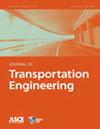Allowing for Psychological Comprehensive Perception Value in Transfer Decision of Public Transit
Q Engineering
引用次数: 0
Abstract
To explore traveler transfer decisions for different purposes, a transfer decision model allowing psychological comprehensive perception value is built based on cumulative prospect theory. Combined with the value function of the arrival time and time value model, the cost function of psychological comprehensive perception is established, and the reference point of psychological comprehensive perception is set. Travel cumulative prospect models of bus interchanges and bus transfers to subways chosen by commuters and noncommuters are established, and the two-dimensional (departure time and travel mode) optimal travel decisions of commuters and noncommuters are obtained based on the calculation results. The results show that traveler cumulative prospect value first increases and then decreases with the delay of departure time, and the peak value’s occurrence time of a bus transfer to a subway is later than that of a bus interchange. Cumulative prospect value decreases as the transfer time increases when travelers’ arrive at the destination at the same time. Commuters obtain higher gains when they choose late departure time and bus transfer to the subway with determined transfer time, while noncommuters obtain higher gains with the opposite choice. The results show that traveler comprehensive psychological perception not only depends on arrival time but also depends on departure time, travel time in different stages, and cost. Travelers have different risk preferences for different travel purposes, and commuters’ time value is high, which determines whether they tend to pursue risk. Noncommuters tend to avoid risk. This conclusion can provide a theoretical basis for transfer decisions to improve satisfaction with public transit.在公交换乘决策中考虑心理综合感知价值
为了探讨不同目的下的旅客迁移决策,基于累积前景理论建立了一个允许心理综合感知价值的迁移决策模型。结合到达时间的价值函数和时间价值模型,建立心理综合感知的成本函数,设置心理综合感知的参考点。建立通勤者和非通勤者选择公交换乘和换乘地铁的出行累积前景模型,并根据计算结果得到通勤者和非通勤者的二维(出发时间和出行方式)最优出行决策。结果表明:随着发车时间的延迟,乘客累积前景值先增大后减小,公交换乘地铁的峰值出现时间晚于公交换乘的峰值出现时间;当旅客同时到达目的地时,累积前景值随着换乘时间的增加而减小。通勤者在公交换乘时间确定的情况下,选择晚出发时间换乘地铁,收益较高,而非通勤者选择晚出发时间换乘地铁,收益较高。结果表明,出行者的综合心理感知不仅与到达时间有关,还与出发时间、不同阶段旅行时间和费用有关。旅行者对不同的出行目的有不同的风险偏好,通勤者的时间价值较高,这决定了他们是否倾向于追求风险。不通勤的人倾向于避免风险。该结论可为提高公交满意度的换乘决策提供理论依据。
本文章由计算机程序翻译,如有差异,请以英文原文为准。
求助全文
约1分钟内获得全文
求助全文
来源期刊

Journal of Transportation Engineering
工程技术-工程:土木
CiteScore
1.22
自引率
0.00%
发文量
0
审稿时长
3.6 months
期刊介绍:
Information not localized
 求助内容:
求助内容: 应助结果提醒方式:
应助结果提醒方式:


